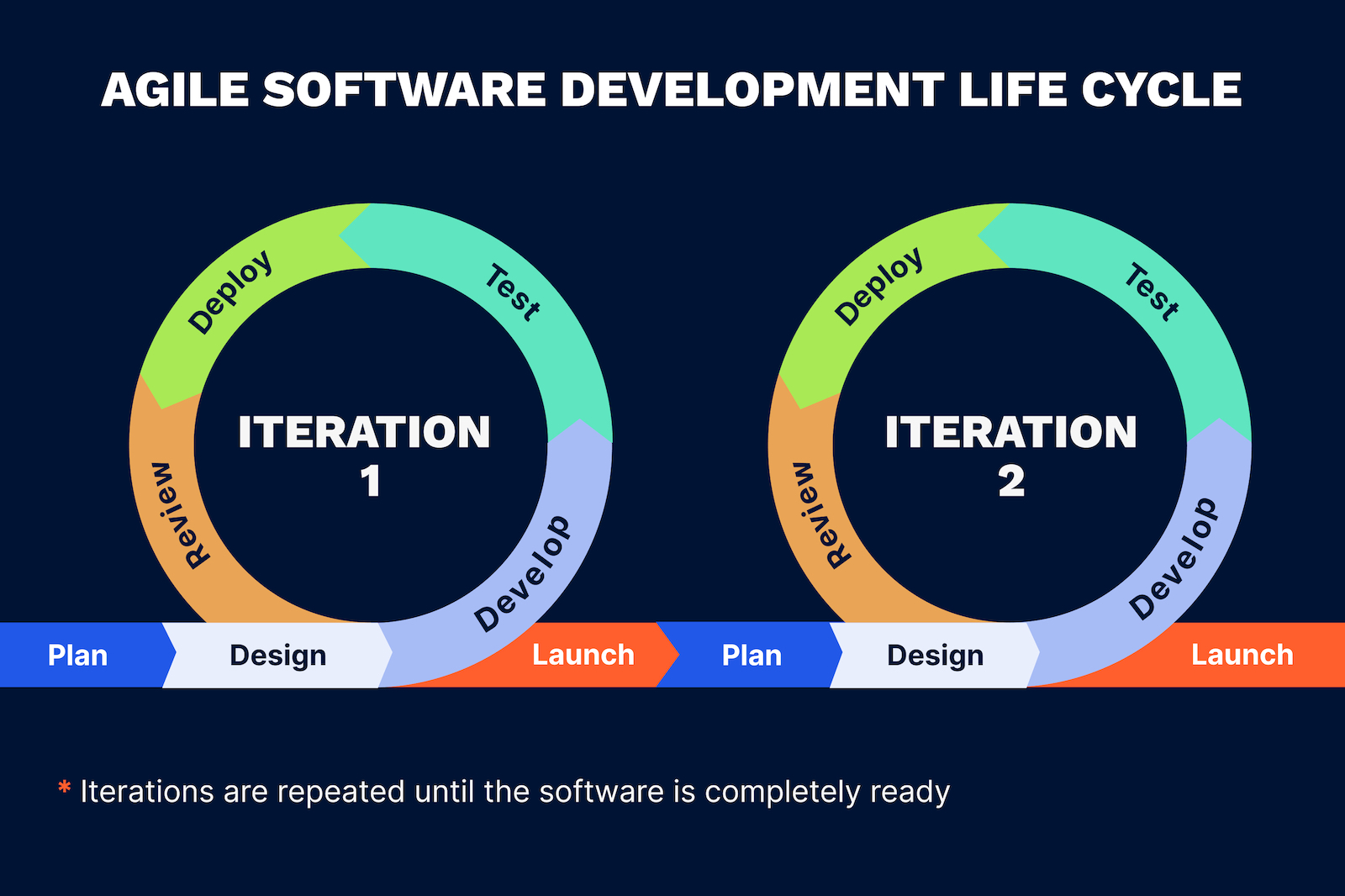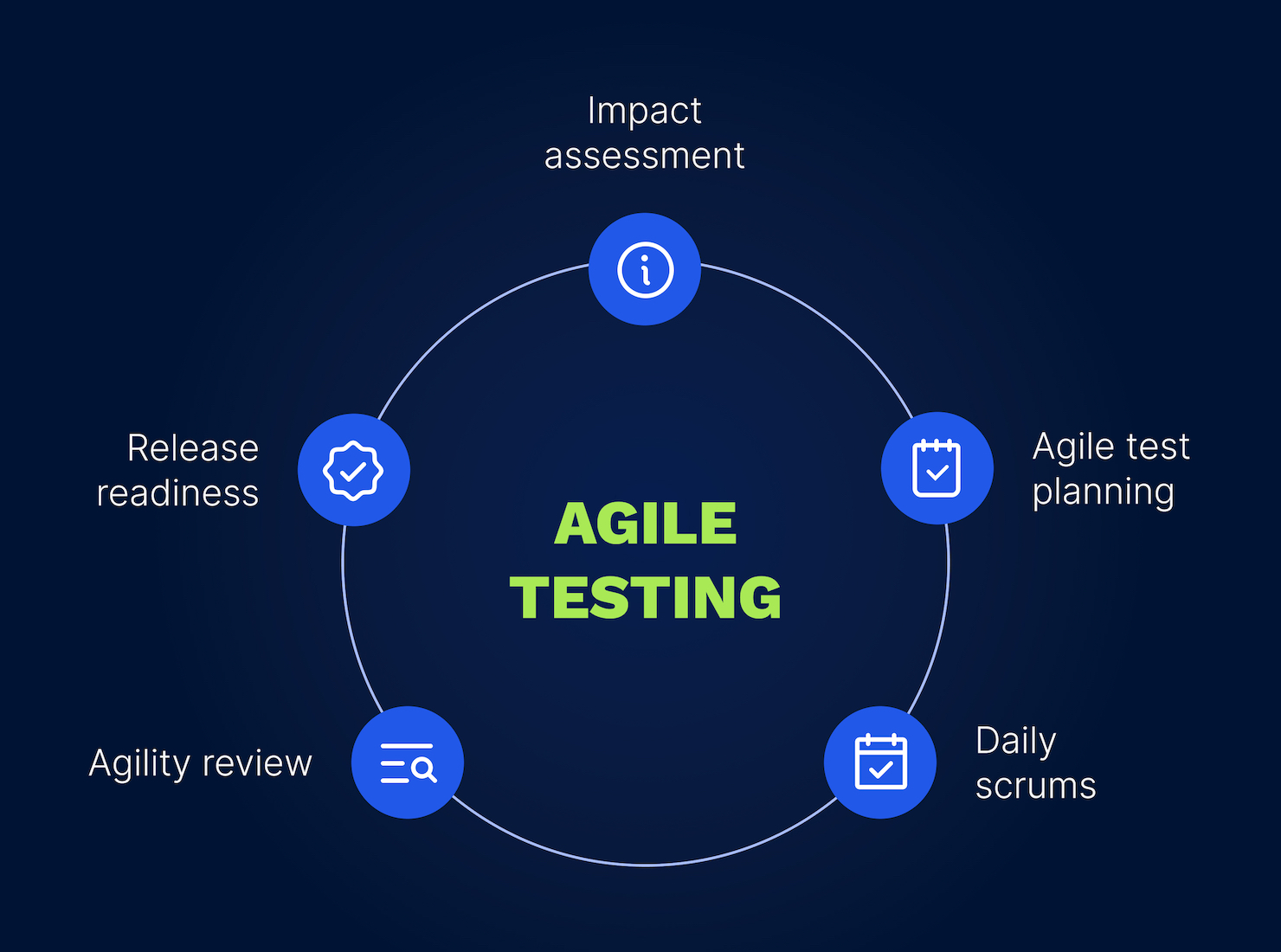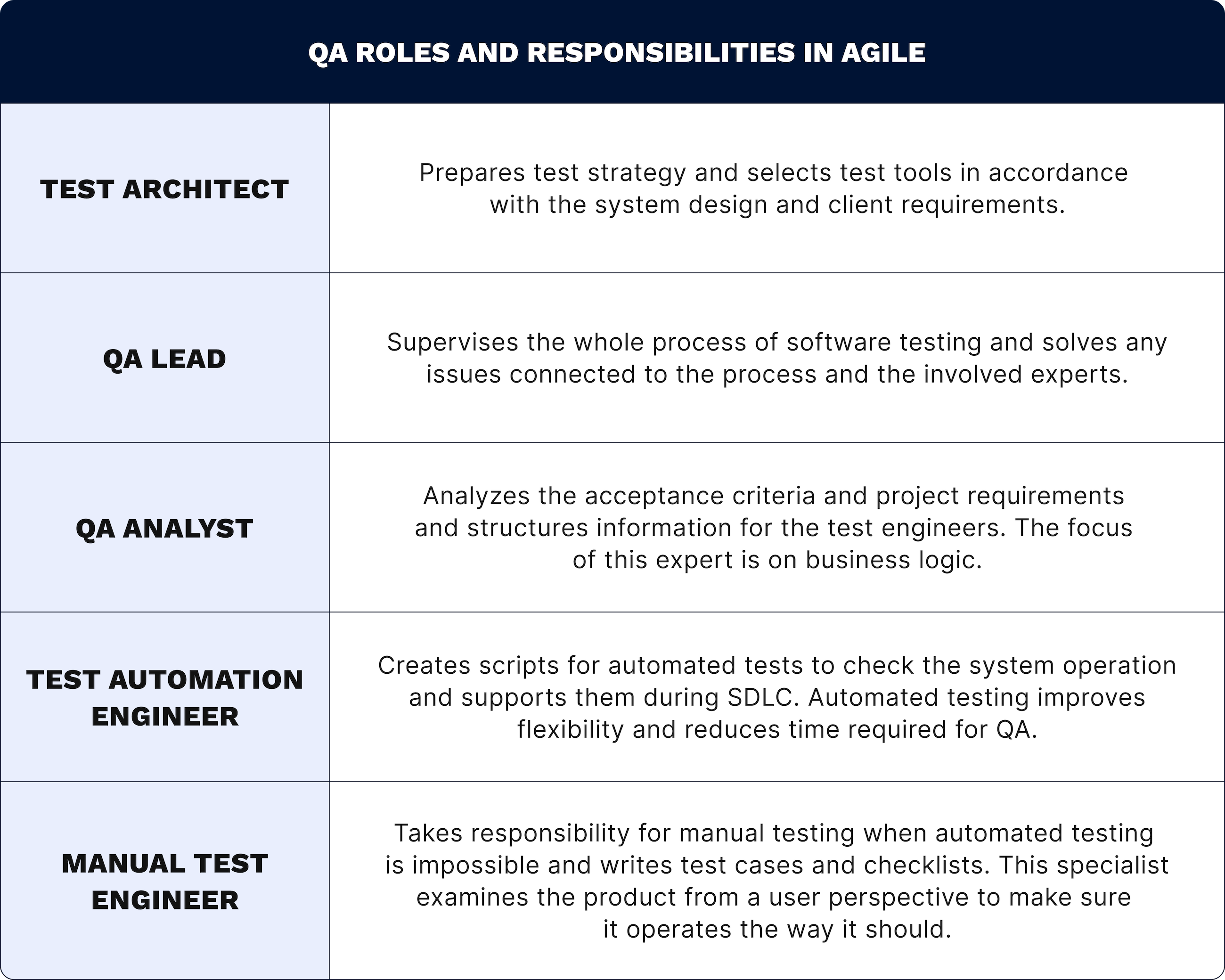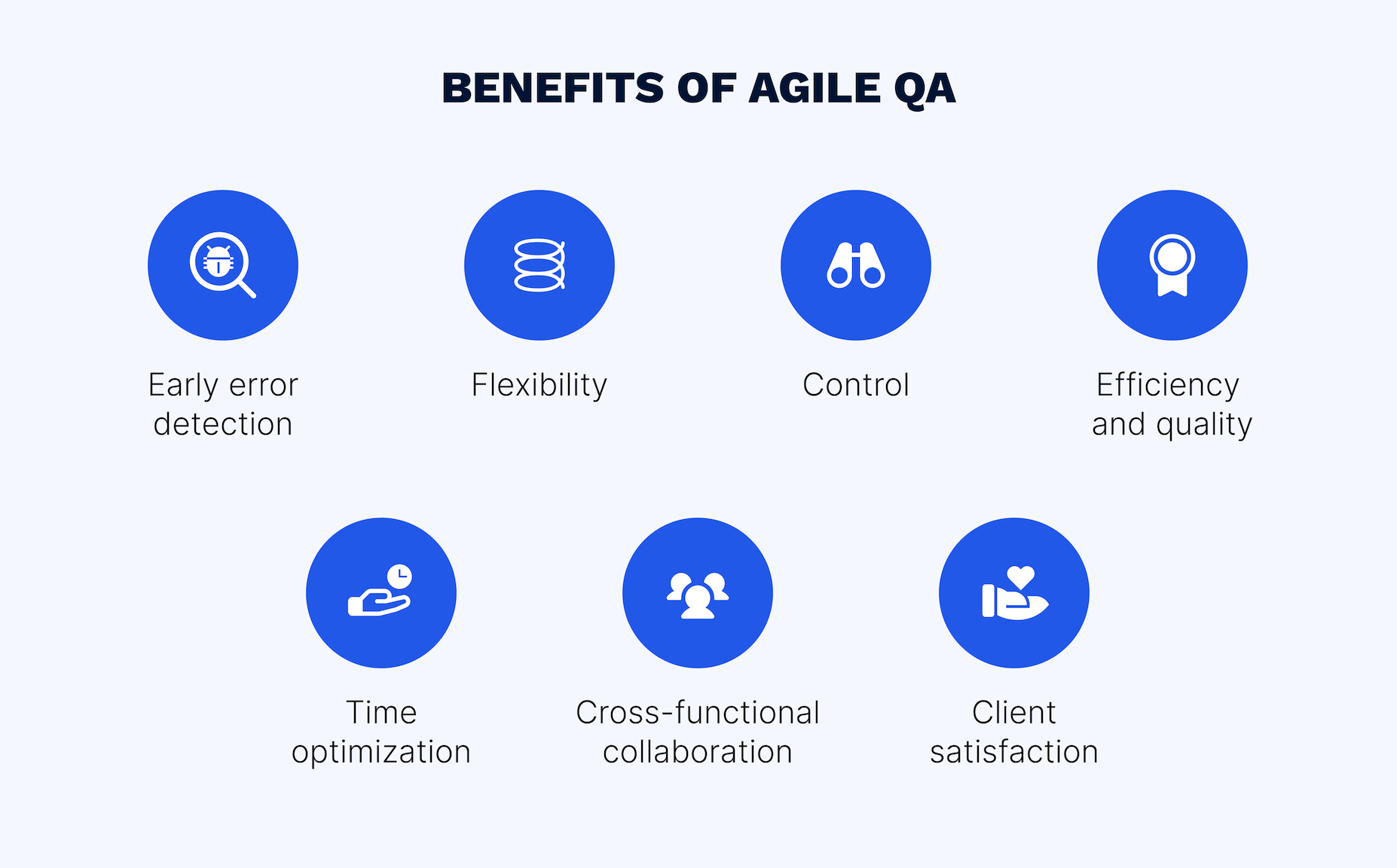
Contact us
Our team would love to hear from you.

Agile development is based on constant iterations and sprints, making quality assurance (QA) a part of each of them and not just one of the final procedures before product release. For testing not to become the bottleneck of the Agile processes, QA has to keep up with the pace. Alignment of QA and development is important for creating an efficient workflow.
In this article, we describe the QA testing process in Agile, including Agile methodologies and the ways to make the most of QA.
Before going into the details of the QA process, we need to answer the following question: what is Agile testing? QA testing is a process that checks the functionality of the product and ensures that it meets user demands, as well as regulations and standards. The main goal is high-quality software.
In a traditional software development life cycle, the Waterfall model, testing comes towards the end of the project, when the product is almost complete. In Agile, QA testing should be involved throughout the whole development process, with QA not just following the development, but supporting it. QA testing should be implemented early and continuously, with constant feedback to developers to ensure that any issues are fixed quickly.

There are some principles of Agile testing that are fundamental for the process:
QA life cycle in Agile consists of five main stages.
This stage involves implementing requirements analysis and gathering information from stakeholders and users as input for the following stages. Here, test purposes and objectives for each sprint are decided upon as well.
During Agile test planning, the team determines the testing scope and timeline, as well as methods and tools that should be used during QA. It also includes scheduling and establishing expected outcomes.
Agile development cannot be productive without daily meetups, and the same goes for QA. The team holds meetings to share status updates, set goals for the next day, and discuss any potential issues that may interfere with delivery.
An essential part of Agile QA testing is regular analysis and evaluation of the project’s progress to confirm that the development is going according to plan.
This stage of the QA testing process involves assessing the features developed in a given iteration to identify whether they are ready or need to be improved and go through the previous development stages again.
Agile QA process flow diagram can be displayed in the following way:

Before starting the QA testing process, it’s necessary to develop a test plan, which, in Agile, is created and updated for each iteration. The test plan structure can vary depending on the requirements, but it should contain general information on all the test cases and test runs, as well as the frequency and number of tests.
Agile test plan can include the following components:
The QA team should be able to refer to this plan at any time to be sure that everything goes accordingly. Creating a detailed and clearly structured test plan helps simplify and enhance QA processes.

A QA team can consist of different experts each having their own duties. Depending on the project complexity, the team structure may vary. Here are a few key QA roles and responsibilities in Agile:

These are just several experts that can be engaged in the QA testing process. A QA team can also involve Quality Control Engineers, Test Consultants, Test Managers, Tech Leads, Performance QA Engineers, and other specialists.
Selecting the methodology of Agile QA depends on the objectives that you pursue. The following are some of the frequently used ones.
TDD is based on the interaction between developers and QA specialists and the intertwining of three different processes: coding, testing, and refactoring. This methodology implies that unit test cases are created before the development. Then, the team creates a simple code that is just enough to pass these tests. The developers can also refactor the created code to improve it without affecting the simplicity or changing the behavior.
ATDD means writing acceptance tests combining three different perspectives: business, developer, and tester, referred to as the three amigos. Like the previous methodology, ATDD involves creating tests before code development, but unlike TDD, this development relies on acceptance tests and not unit tests. The focus is on the application’s functionality from the user’s point of view, where acceptance test cases act as requirements.
This QA Agile methodology derives from TDD and ATDD, augmenting them and focusing on systems behavior. Just like ATDD, BDD depends on the three amigos and the collaboration between them. BDD tests use business-facing scenarios to describe the behavior of a story, feature, or capability. Automated BDD tests ensure that the system behavior meets the requirements every time.

The QA process in Agile methodology offers benefits that can play a key role in software development.
Since testing is implemented early and continuously, it becomes easy to find and fix any issues instantly, without the need to wait for the product to be finished.
Every project is divided into sprints and each sprint involves quality assurance. This approach to the QA process allows implementing a thorough testing of a product, ensuring that the final version of it is of high quality.
Constant collaboration between team members and teams throughout the whole project ensures that everyone is in sync and knows their responsibilities, maximizing productivity.
Agile implies continuous interaction not only among teams, but with clients as well. QA specialists and developers meet the client’s needs and improve the product by acting on their feedback immediately.
The iterative and incremental nature of Agile testing reduces time, as QA is implemented in each sprint and does not require extensive documentation.
Adaptability and flexibility are some of the main ideas of Agile. QA specialists can give and receive feedback quickly and act on it, promptly solving issues and responding to changes.
Each sprint is broken down into small tasks, making the QA process easily manageable and improving productivity.
How can you make the most of the QA process in Agile? Following are some valuable tips for QA to be even more effective.
Automate everything that can be automated, as manual testing takes too much time. This helps boost productivity, improve the workflow, and save time. Automation allows a QA team to avoid testing the same functionality over and over again. Moreover, it is possible to create tests that can be used by other teams as well.
One of the core values of the Agile Manifesto is working software over comprehensive documentation. The traditional development flow requires creating detailed documentation before even starting the development itself. Agile methodology puts high-quality results above all. And the QA process is no exception — create documentation only if it brings value.
Another Agile Manifesto value puts individuals and interactions over processes and tools. It’s important to communicate and collaborate with other teams to solve any problems and achieve great results. It’s also essential to integrate the QA team into the development as early as possible to get quick feedback and make all the improvements promptly.
The target audience should be the center of attention. The QA team needs to keep in mind who is going to use the software and the ways they are going to use it to build the QA testing process around this knowledge. User-centric thinking gives another perspective on software, allowing teams to develop a valuable product.
This is one of the main principles of software testing in Agile and is worth mentioning one more time. The success of an Agile project is based on continuous feedback and cooperation, where different teams work hand in hand. It’s important to test software after every change, update, revision, and improvement of code to determine whether developers need to make additional alterations and to ensure that everything works as intended.
The main idea of the QA process in Agile implies early and continuous testing, attention to collaboration among teams, constant interaction with the client, and focus on flexibility. Knowing how QA works in Agile, its stages, the methodologies, and the best practices can considerably increase productivity and improve software quality.
Our QA approach to Agile projects can be your key to top-notch solutions. Contact the EffectiveSoft team to learn more about our services.
Our team would love to hear from you.
Fill out the form, and we’ve got you covered.
What happens next?
San Diego, California
4445 Eastgate Mall, Suite 200
92121, 1-800-288-9659
San Francisco, California
50 California St #1500
94111, 1-800-288-9659
Pittsburgh, Pennsylvania
One Oxford Centre, 500 Grant St Suite 2900
15219, 1-800-288-9659
Durham, North Carolina
RTP Meridian, 2530 Meridian Pkwy Suite 300
27713, 1-800-288-9659
San Jose, Costa Rica
Escazú Corporate Centre, Piso 6
40602, 1-800-288-9659